Mesoscale/Microscale and CFD Modeling for Wind Resource Assessment: Application to the Andaman Coast of Southern Thailand
Abstract
:1. Introduction
2. Materials and Methods
2.1. Characteristics of the Study Area
2.2. Input Data
2.3. Wind Resource Modeling: Coupled Mesoscale and Microscale Modeling
2.3.1. Mesoscale Modeling
2.3.2. Microscale Modeling
2.4. Wind Resource Modeling CFD and Wake Loss Modeling
2.5. Wind Maps Validation
2.6. Annual Energy Production and Capacity Factors
3. Results and Discussion
3.1. Wind Resource Maps
3.2. Wind Power Potentail
3.3. Annual Energy Production and Capacity Factor
4. Conclusions
Author Contributions
Funding
Data Availability Statement
Acknowledgments
Conflicts of Interest
References
- Electricity Generating Authority of Thailand (EGAT). Statistical Data: Proportion of Electric Power in the Fuel System of EGAT in 2019. Available online: http://www.egat.co.th (accessed on 10 December 2021).
- International Renewable Energy Agency (IRENA). Energy Profile Thailand. Available online: https://www.irena.org/IRENADocuments/Statistical_Profiles/Asia/Thailand_Asia_RE_SP.pdf (accessed on 10 December 2021).
- Energy Policy and Planning Office (EPPO). Energy Statistics. Available online: http://www.eppo.go.th/index.php/en/en-energystatistics/electricity-statistic (accessed on 10 December 2021).
- International Renewable Energy Agency (IRNA). Renewable Power Generation Costs in 2018. Available online: https://www.irena.org/publications/2019/May/Renewable-power-generation-costs-in-2018 (accessed on 10 December 2021).
- International Renewable Energy Agency (IRENA). Renewable Power Market Analysis: GCC2019. Available online: https://www.irena.org/publications/2020/Jun/Renewable-Power-Costs-in-2019 (accessed on 10 December 2021).
- Global Wind Energy Council (GWEC). GWEC Global Wind Report 2019. Available online: www.gwec.net (accessed on 10 December 2021).
- Department of Alternative Energy Development and Efficiency. Wind Resource Assessment of Thailand, Final Report (E-Book). Available online: http://www2.dede.go.th/dede/renew/Twm/REPORT.html (accessed on 10 December 2021).
- The World Bank Asia Alternative Energy Program. Wind Energy Resource Atlas of Southeast Asia. Available online: http://documents1.worldbank.org/curated/en/252541468770659342/pdf/318700Wind0energy0atlas0complete.pdf (accessed on 10 December 2021).
- Manomaiphiboon, K.; Prabamroong, A.; Chanaprasert, W.; Rajpreeja, N.; Phan, T.T. Wind Resource Assessment Using Advanced Atmospheric Modeling and GIS Analysis: Final Report, 1st ed.; Thailand Research Fund: Bangkok, Thailand, 2010. [Google Scholar]
- Janjai, S.; Masiri, I.; Promsen, W.; Pattarapanitchai, S.; Pankaew, P.; Laksanaboonsong, J.; Bischoff-Gauss, I.; Kalthoff, N. Evaluation of Wind Energy Potential over Thailand by using an Atmospheric Mesoscale Model and a GIS Approach. J. Wind. Eng. Ind. Aerodyn. 2014, 129, 1–10. [Google Scholar] [CrossRef]
- Waewsak, J.; Landry, M.; Gagnon, Y. High Resolution Wind Atlas for Nakhon Si Thammarat and Songkhla Provinces, Thailand. Renew. Energy 2013, 53, 101–110. [Google Scholar] [CrossRef]
- Waewsak, J.; Chancham, C.; Chiwamongkhonkarn, S.; Gagnon, Y. Wind Resource Assessment of the Southernmost Region of Thailand Using Atmospheric and Computational Fluid Dynamics Wind Flow Modeling. Energies 2019, 12, 1899. [Google Scholar] [CrossRef] [Green Version]
- Waewsak, J.; Ali, S.; Nathee, W.; Kongruang, C.; Chancham, C.; Gagnon, Y. Assessment of Hybrid, Firm Renewable Energy-Based Power Plants: Application in the Southernmost Region of Thailand. Renew. Sustain. Energy Rev. 2020, 130, 109953. [Google Scholar] [CrossRef]
- Department of Alternative Energy Development and Efficiency, Ministry of Energy. Available online: https://weben.dede.go.th/webmax/content/dede’s-15-mw-wind-power-pilot-project-proven-be-great-success (accessed on 10 December 2021).
- Energy Policy and Planning Office. Thailand Power Development Plan 2018–2036 (PDP 2018). Available online: http://www.eppo.go.th/index.php/en/policy-and-plan/en-tieb/tieb-pdp (accessed on 10 December 2021).
- Department of Alternative Energy Development and Efficiency, Ministry of Energy. Performance on Alternative Energy Policy: January 2020. Available online: https://weben.dede.go.th/webmax/content/annual-report-2015-department-alternative-energy-development-and-efficiency (accessed on 10 December 2021).
- Energy Regulatory Commission (ERC). Energy Data Center, SPP/VSPP Database System. Available online: http://www.erc.or.th/ERCSPP (accessed on 10 December 2021).
- Peña, A.; Hasager, C.B. Remote Sensing for Wind Energy, 1st ed.; Risø National Laboratory for Sustainable Energy: Roskilde, Denmark, 2011. [Google Scholar]
- Lucchesi, R. File Specification for MERRA Products. GMAO Office Note No.1 (Version 2.3). Available online: http://gmao.gsfc.nasa.gov/pubs/office_notes (accessed on 15 May 2019).
- Weekes, S.M.; Tomlin, A.S.; Vosper, S.B.; Skea, A.K.; Gallani, M.L.; Standen, J.J. Long-Term Wind Resource Assessment for Small and Mediun-Scale Turbines using Operational Forecast Data and Measure-Correlate-Predict. Renew. Energy 2015, 81, 760–769. [Google Scholar] [CrossRef] [Green Version]
- Veronesi, F.; Grassi, S.; Raubal, M. Statistical Learning Approach for Wind Resource Assessment. Renew. Sustain. Energy Rev. 2016, 56, 836–850. [Google Scholar] [CrossRef]
- Murthy, K.S.R.; Rahi, O.P. A Comprehensive Review of Wind Resource Assessment. Renew. Sustain. Energy Rev. 2017, 72, 1320–1342. [Google Scholar] [CrossRef]
- Beaucage, P.; Brower, M.C.; Tensen, J. Evaluation of Four Numerical Wind Flow Models for Wind Resource Mapping. Wind. Energy 2012, 17, 197–208. [Google Scholar] [CrossRef]
- Carvalho, D.; Rocha, A.; Silva Santos, C.; Pereira, R. Wind Resource Modelling in Complex Terrain using Different Mesoscale-Microscale Coupling Techniques. Appl. Energy 2013, 108, 493–504. [Google Scholar] [CrossRef] [Green Version]
- Waewsak, J.; Landry, M.; Gagnon, Y. Offshore Wind Power Potential of the Gulf of Thailand. Renew. Energy 2015, 81, 609–626. [Google Scholar] [CrossRef]
- Chancham, C.; Waewsak, J.; Gagnon, Y. Offshore Wind Resource Assessment and Wind Power Plant Optimization in the Gulf of Thailand. Energy 2017, 193, 706–731. [Google Scholar] [CrossRef]
- Gasset, N.; Landry, M.; Gagnon, Y. A Comparison of Wind Flow Models for Wind Resource Assessment in Wind Energy Applications. Energies 2012, 5, 4288–4322. [Google Scholar] [CrossRef] [Green Version]
- Mughal, M.O.; Lynch, M.; Yu, F.; Sutton, J. Forecasting and Verification of Winds in an East African Complex Terrain using Coupled Mesoscale—And Microscale Models. J. Wind Eng. Ind. Aerodyn. 2018, 176, 13–20. [Google Scholar] [CrossRef]
- Bilal, M.; Birkelund, Y.; Homola, M.; Virk, M.S. Wind over Complex Terrain—Microscale Modeling with Two Types of Mesoscale Wind at Nygårdsfjell. Renew. Energy 2016, 99, 647–653. [Google Scholar] [CrossRef]
- Boopathi, K.; Kushwaha, R.; Balaraman, K.; Bastin, J.; Kanagavel, P.; Prasad, R. Assessment of wind power potential in the coastal region of Tamil Nadu, India. Ocean. Eng. 2021, 219, 108356. [Google Scholar] [CrossRef]
- Potic, I.; Joksimovic, T.; Millincic, U.; Kicovic, D.; Milincic, M. Wind energy potential for the electricity production—Knjazevac Municipality cast study (Serbia). Energy Strategy Rev. 2021, 33, 100589. [Google Scholar] [CrossRef]
- Jameel, M.A.; Syed, A.; Ali, F.; Imran, M. A techno-economic analysis for power generation through wind energy: A case study of Pakistan. Energy Rep. 2021, 7, 1424–1443. [Google Scholar]
- Chaichan, W.; Waewsak, J.; Gagnon, Y. A Systematic Decision-Making Approach for the Assessment of Hybrid Renewable Energy Application with Techno-Economic Optimization: Application to the Rajamangala University of Technology Srivijaya (Trang Campus), Southern Thailand, Songklanakarin. J. Sci. Technol. 2021, 43, 1800–1806. [Google Scholar]
- Gasset, N.; Yu, W. WEST (Wind Energy Simulation Toolkit) Tutorial, 1st ed.; Recherche en Prevision Numerique, Environment Canada: Montréal, QC, Canada, 2011. [Google Scholar]
- Meissner, D. WindSim Getting Started, WindSim 7, 8th ed.; WindSim As.: Tønsberg, Norway, 2015. [Google Scholar]
- Ranthodsang, M.; Waewsak, J.; Kongruang, C.; Gagnon, Y. Offshore Wind Power Assessment on the Western Coast of Thailand. Energy Rep. 2020, 6, 1135–1146. [Google Scholar] [CrossRef]
- Land Development Department, Ministry of Natural Resources and Environment, Royal Thai Government. Land Use and Topography Databases. Available online: http://www1.ldd.go.th/WEB_OLP/report_research_S.html (accessed on 15 May 2018).
- Niewiadomski, M.; Leung, Y.C.D.; Benoit, R. Simulations of Wind Field and Other Meteorological Parameters in the Complex Terrain of Hong Kong Using MC2—A Mesoscale Numerical Model. J. Wind Eng. Ind. Aerodyn. 1999, 80, 71–82. [Google Scholar] [CrossRef]
- Yu, W.; Benoit, R.; Girard, C.; Glazer, A.; Lemarquis, D.; Salmon, J.R.; Pinard, J.P. Wind Energy Simulation Toolkit (WEST): A Wind Mapping System for Use by Wind Energy Industry. Wind Eng. 2009, 30, 15–33. [Google Scholar] [CrossRef]
- Pinard, J.P.; Benoit, R.; Wildson, J.D. Mesoscale Wind Climate Modelling in Steep Mountains. Atmos.-Ocean 2009, 47, 63–67. [Google Scholar] [CrossRef] [Green Version]
- Canadian Hydraulics Centre. AnemoScope Wind Energy Simulation and Mapping Reference Guide, 1st ed.; Cacadian Hydraulics Centre, Environment Canada: Montréal, QC, Canada, 2006. [Google Scholar]
- Katic, I.; Højstrup, J.; Jensen, N.O. A simple model for cluster efficiency. In Proceedings of the European Wind Energy Association Conference & Exhibition, Rome, Italy, 7–9 October 1986. [Google Scholar]
- Pinard, J.P.; Benoit, R.; Yu, W. A West Wind Climate Simulation of Mountainous Yukon. Atmos.-Ocean 2005, 43, 259–281. [Google Scholar] [CrossRef]
- Wakes, S.J.; Maegli, T.; Dickinson, K.J.; Hilton, M.J. Numerical Modelling of Wind Flow over a Complex Topography. Environ. Model. Softw. 2010, 25, 237–247. [Google Scholar] [CrossRef]
- Tabas, D.; Fang, J.; Porté-Agel, F. Wind Energy Prediction in Highly Complex Terrain by Computational Fluid Dynamics. Energies 2019, 12, 1311. [Google Scholar] [CrossRef] [Green Version]
- Temel, O.; Porchetta, S.; Bricteux, L.; Beeck, J.V. RANS Closures for Non-Neutral Microscale CFD Simulations Sustained with Inflow Conditions Acquired from Mesoscale Simulations. Appl. Math. Model. 2018, 53, 635–652. [Google Scholar] [CrossRef] [Green Version]
- García-Sánchez, C.; Gorlé, C. Uncertainty Quantification for Microscale CFD Simulation Based on Input from Mesoscale Codes. J. Wind Eng. Ind. Aerodyn. 2018, 176, 87–97. [Google Scholar] [CrossRef]
- Rezaeiha, A.; Montazeri, H.; Blocken, B. On the Accuracy of Turbulence Models for CFD Simulations of Vertical Axis Wind Turbines. Energy J. 2019, 180, 838–857. [Google Scholar] [CrossRef]
- Ploster, M.F. Comprehensive Comparison of Analytical Wind Turbine Wake Models with Wind Tunnel Measurements and Wake Model Application on Performance Modelling of a Downstream Turbine. Master’s Thesis, Energy and Environmental Engineering, Norwegian University of Science and Technology, Torgarden, Norway, July 2017. [Google Scholar]
- Salagaso, L.G. Experimental Analysis of Analytical Wake Models for Wind Turbines. Master’s Thesis, Energy Engineering, Aalborg University, Aalborg, Denmark, May 2017. [Google Scholar]
- Archer, C.L.; Vasel-Be-Hagh, A.; Yan, C.; Wu, S.; Pan, Y.; Brodie, J.F.; Maguire, A.E. Review and Evaluation of Wake Loss Models for Wind Energy Applications. Appl. Energy 2018, 226, 1187–1207. [Google Scholar] [CrossRef]
- Göçmen, T.; Laan, P.V.D.; Réthoré, P.E.; Diaz, A.P.; Larsen, G.C. Wind Turbine Wake Models Developed at the Technical University of Denmark: A Review. Renew. Sustain. Energy Rev. 2016, 60, 752–769. [Google Scholar] [CrossRef] [Green Version]
- Ishihara, T.; Qian, G.W. A New Gaussian-Based Analytical Wake Model for Wind Turbines Considering Ambient Turbulence Intensities and Thrust Coefficient Effects. J. Wind Eng. Ind. Aerodyn. 2018, 177, 275–292. [Google Scholar] [CrossRef]
- Rivas, R.A.; Clausen, J.; Hansen, K.S.; Jensen, L.E. Solving the Turbine Positioning Problem for Large Offshore Wind Farms by Simulated Annealing. Wind. Eng. 2009, 3, 287–297. [Google Scholar] [CrossRef]
- WindSim. Available online: http://windsim.com/services/optimized-wind-farm-design.aspx (accessed on 30 April 2020).
- Energy Regulatory Commission (ERC). Proclamation of the Energy Regulatory Commission on Determination of Spacing of Wind Power Plant Project and Capacities for Wind Energy Industry. Available online: http://www.erc.or.th (accessed on 10 December 2021).
- Lackner, M.A.; Rogers, A.L.; Manwell, J.F. Uncertainty Analysis in Wind Resource Assessment and Wind Energy Production Estimation. In Proceedings of the 45th AIAA Aerospace Sciences Meeting and Exhibit, Reno, NV, USA, 8–11 January 2007. [Google Scholar]
- Assasa, M.F. Wind Resource Assessment and Micro-Sitting: Uncertainty Analysis Approach. Master’s Thesis, The Graduate School of Natural and Applied Sciences Energy System Operation and Technology, The Republic of Turkey Bahçeşehir University, Istanbul, Turkey, 2016. [Google Scholar]
- Garrad Hassan and Partners Ltd. GH WindFarmer Theory Manual, 1st ed.; Garrad Hassan: Bristol, UK, 2009. [Google Scholar]
- Measuring Network of Wind Energy Institutes (MEASNET). Evaluation of Site-Specific Wind Conditions. 2016, p. 38. Available online: http://www.measnet.com/wp-content/uploads/2016/05/Measnet_SiteAssessment_V2.0.pdf (accessed on 27 March 2022).
- Thailand Greenhouse Gas Management Organization (Public Organization). Update Emission Factor CFP. Available online: http://thaicarbonlabel.tgo.or.th (accessed on 10 December 2021).

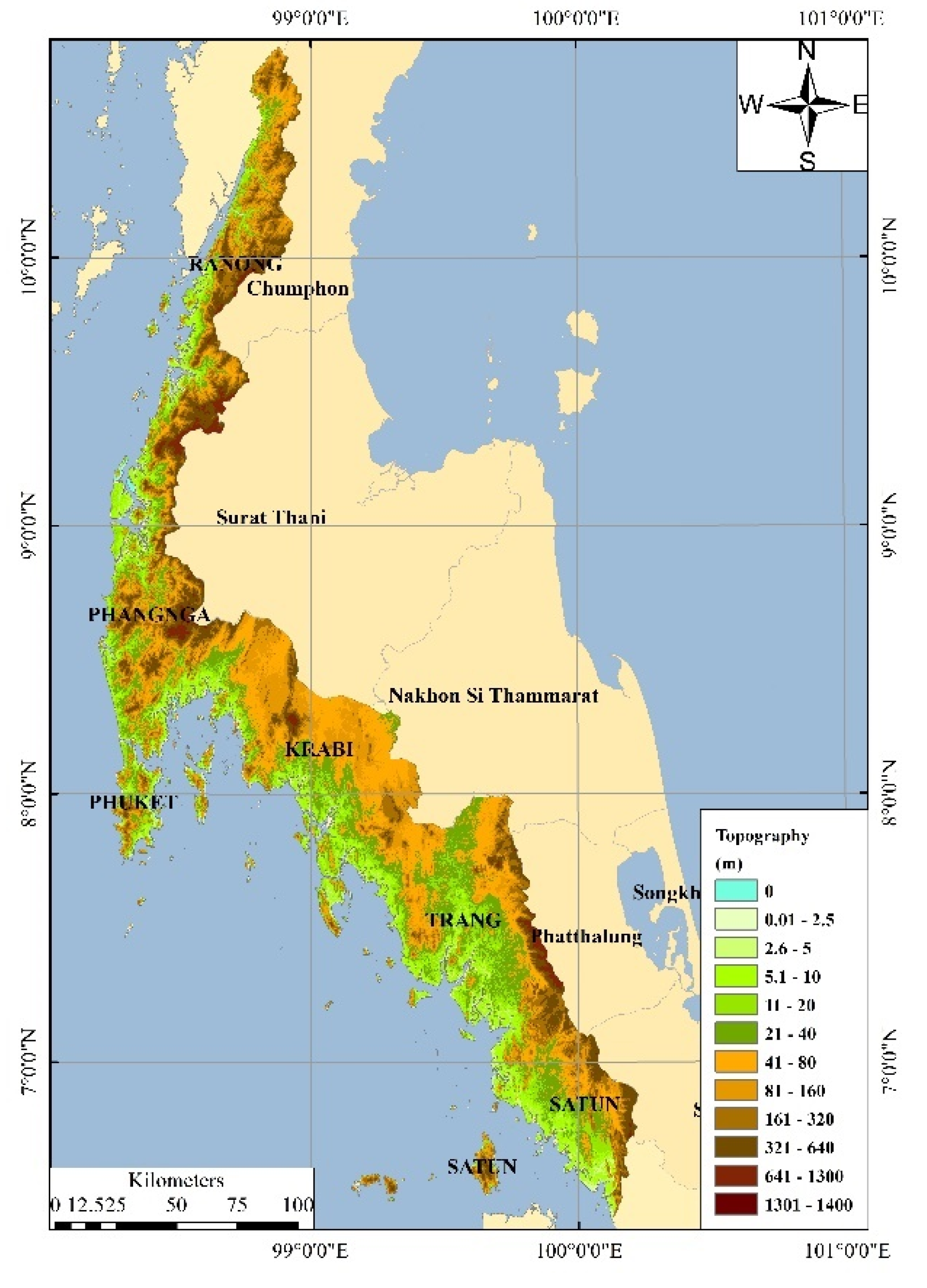
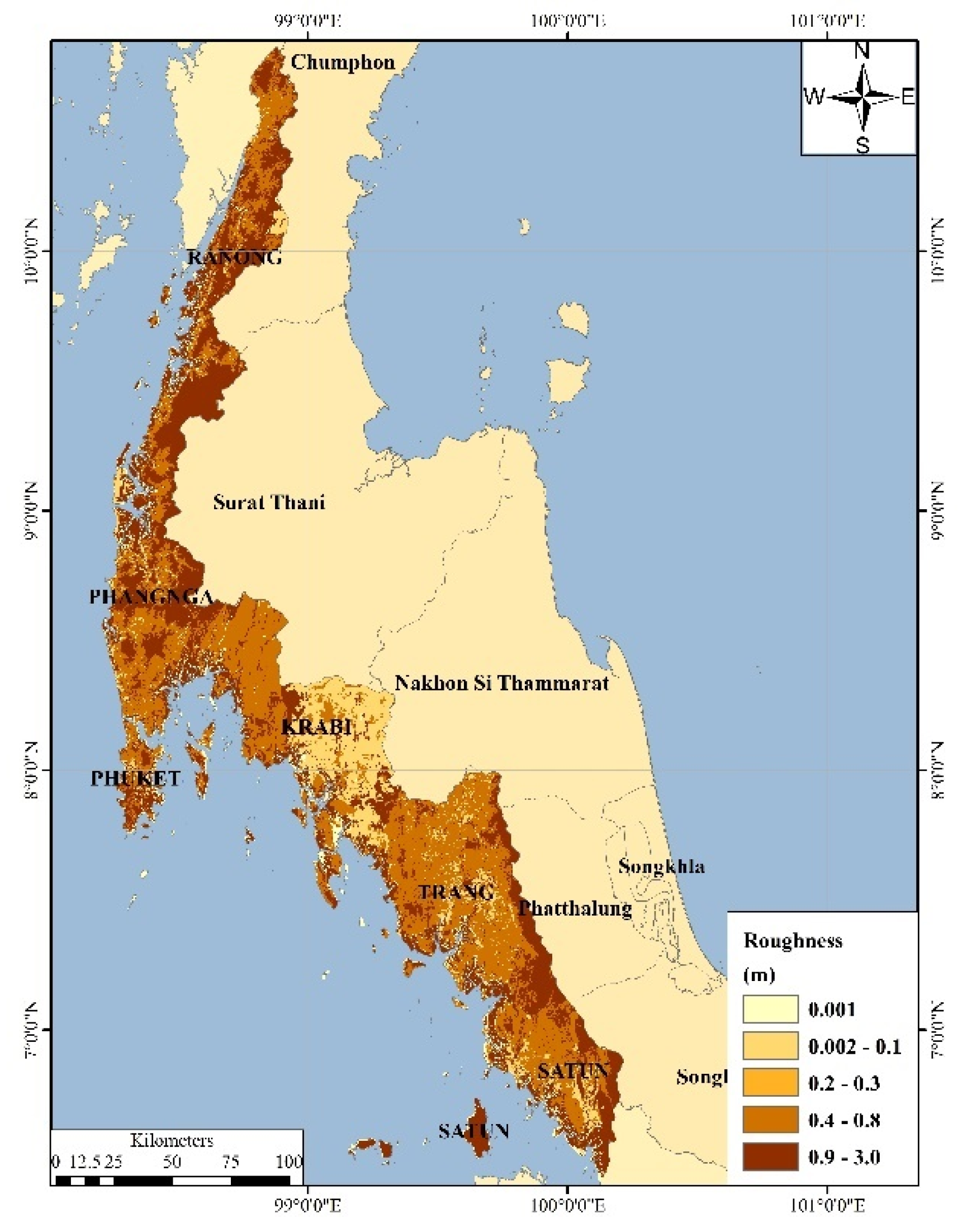
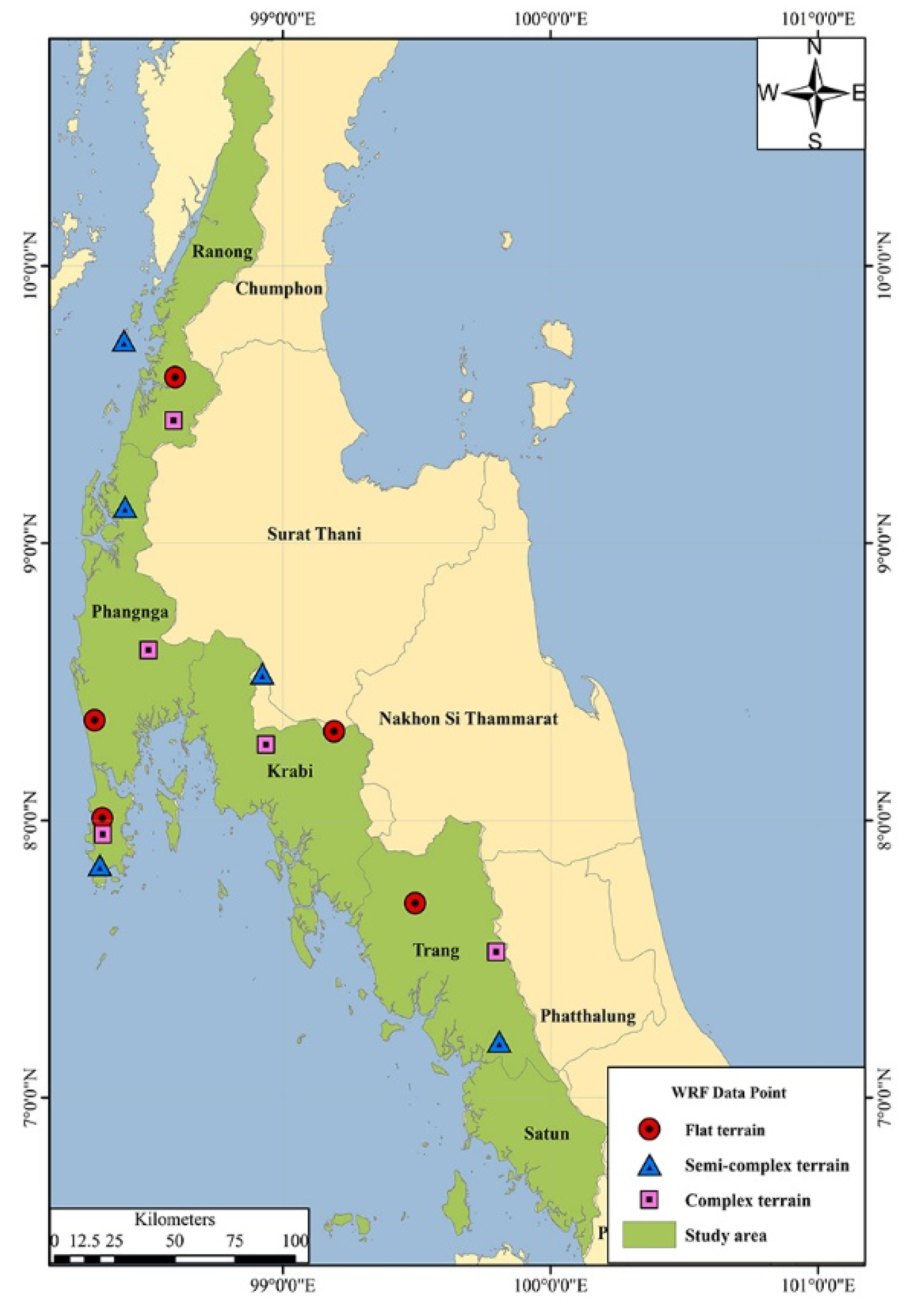

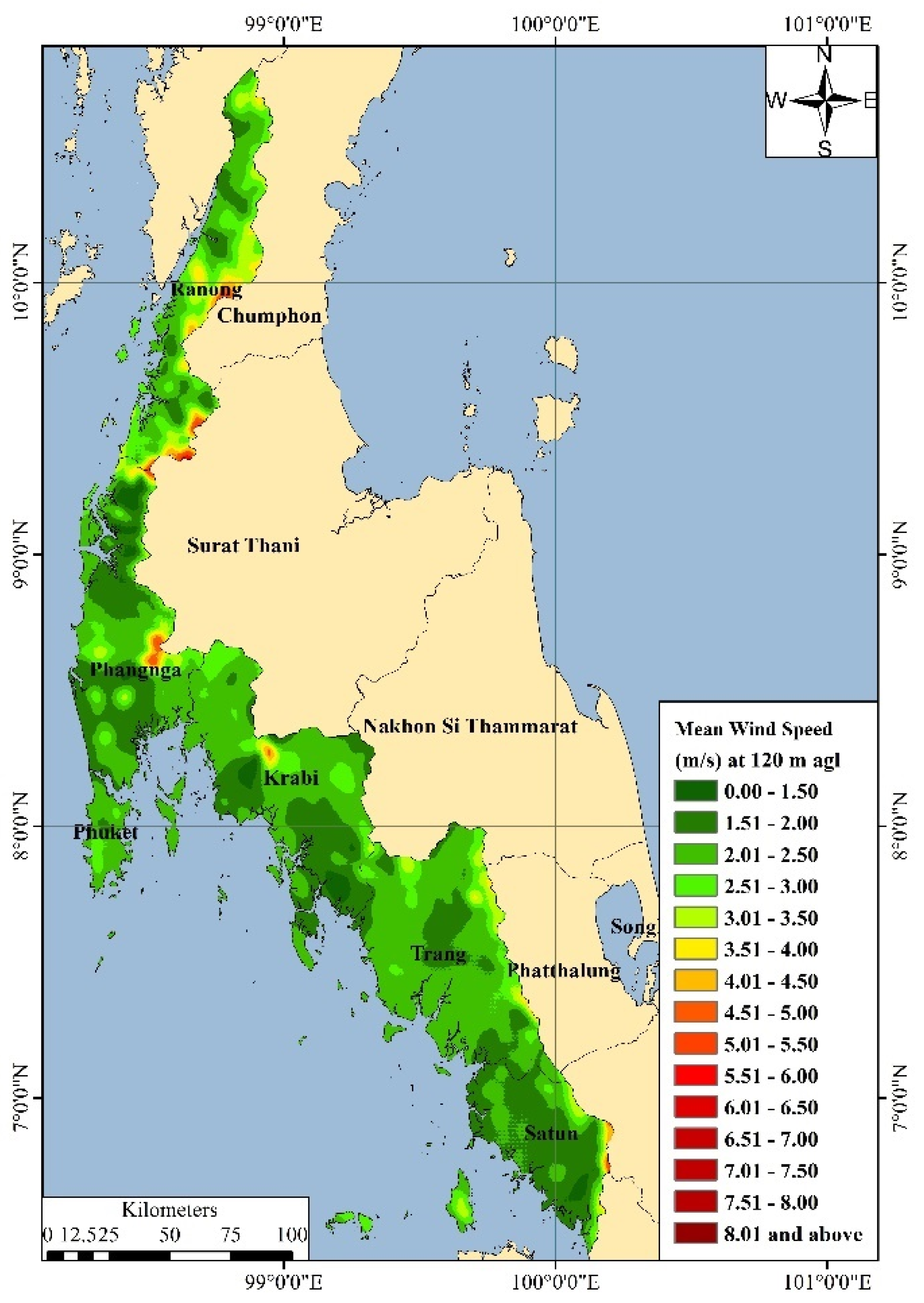

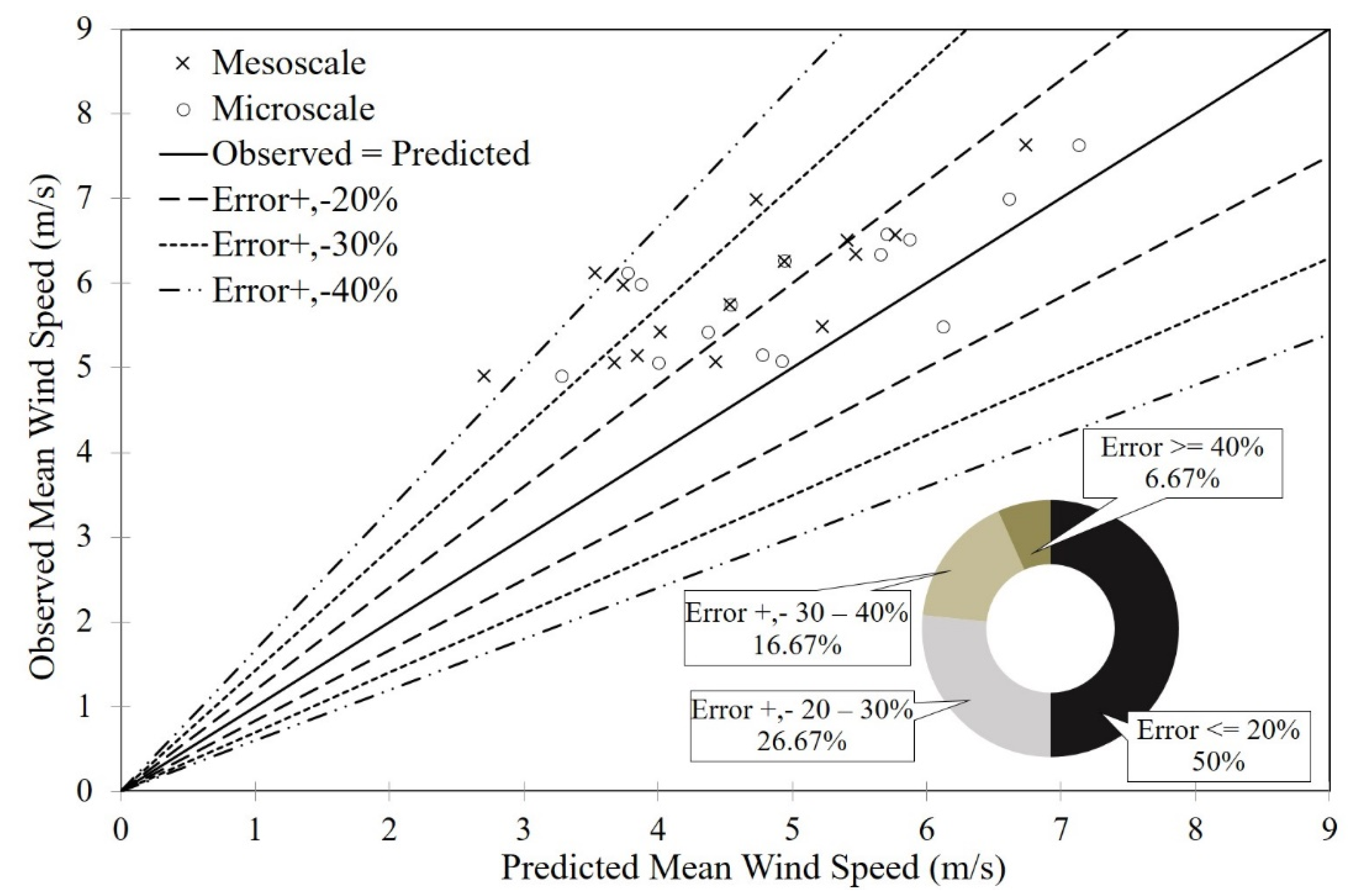


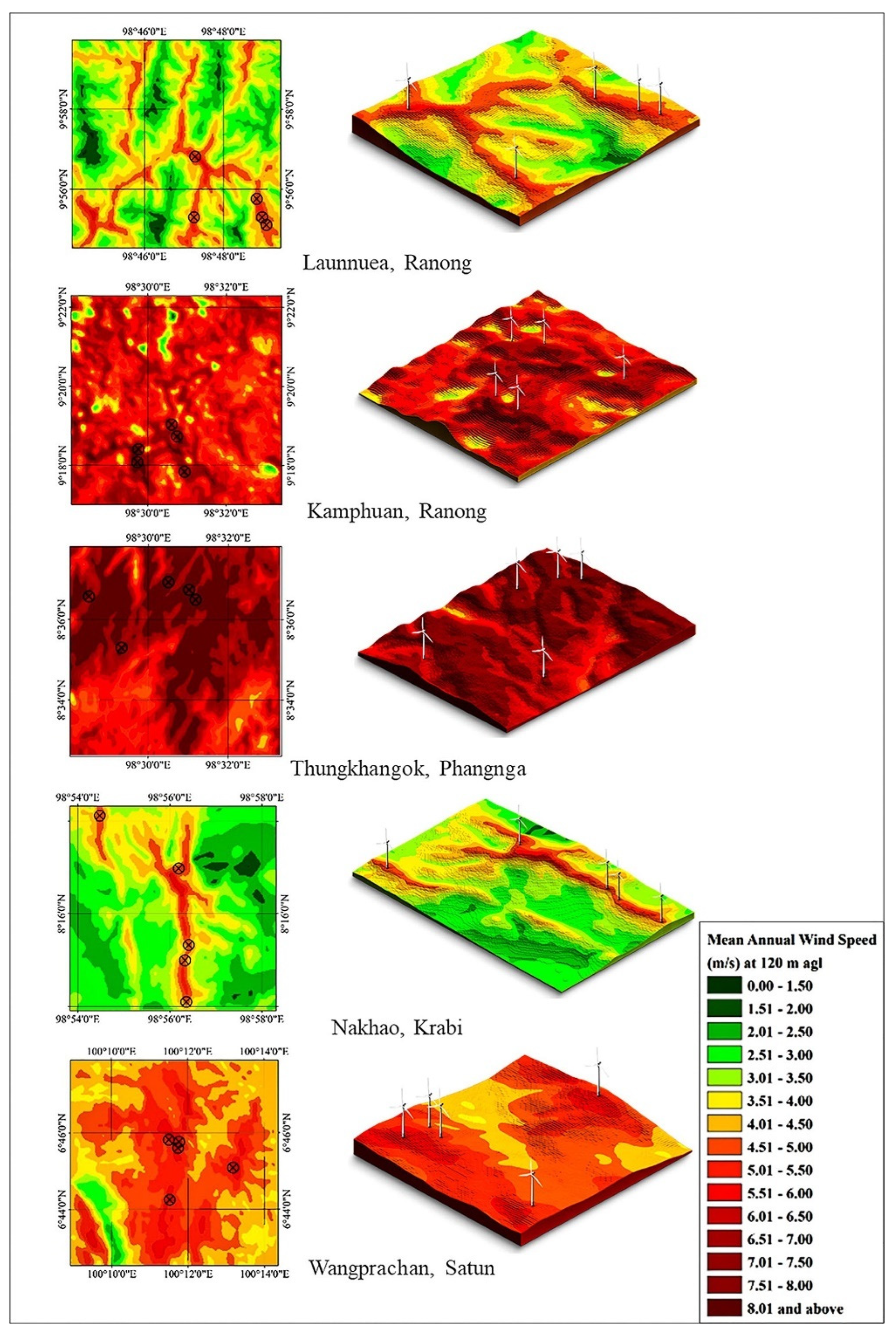

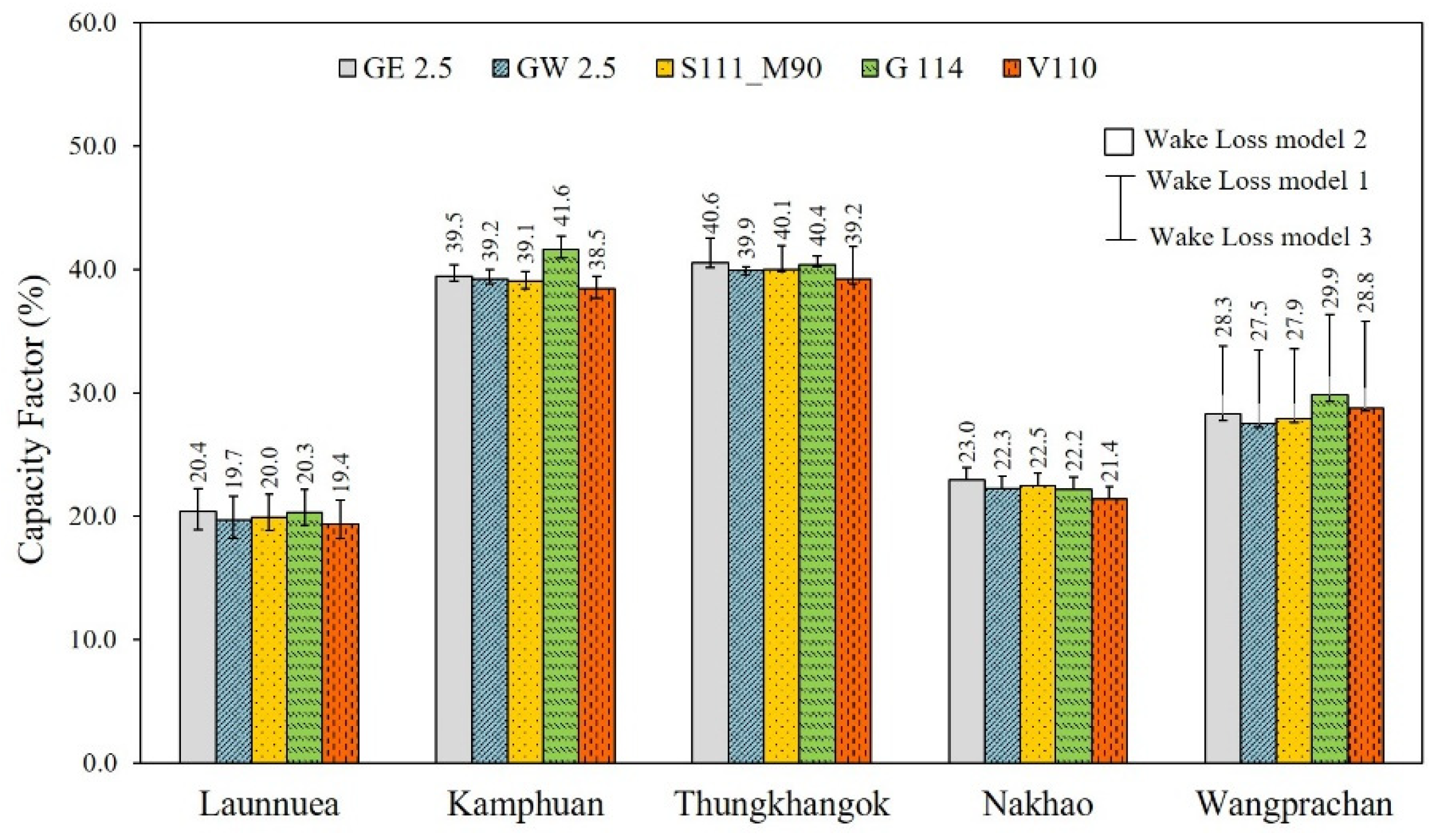
| No. | Site. | Flat Terrain | Semi-Complex Terrain | Complex Terrain | |||
|---|---|---|---|---|---|---|---|
| Longitude (°E) | Latitude (°N) | Longitude (°E) | Latitude (°N) | Longitude (°E) | Latitude (°N) | ||
| 1. | Ranong | 98.597 | 9.598 | 98.406 | 9.732 | 98.592 | 9.443 |
| 2. | Phangnga | 98.296 | 8.361 | 98.41 | 9.132 | 98.498 | 8.615 |
| 3. | Phuket | 98.325 | 8.007 | 98.316 | 7.840 | 98.327 | 7.950 |
| 4. | Krabi | 99.191 | 8.321 | 98.923 | 8.531 | 98.937 | 8.274 |
| 5. | Trang | 99.494 | 7.701 | 99.808 | 7.204 | 99.797 | 7.526 |
| No. | Wind Turbine Generator Model | Hub Height (m) | Rotor Diameter (m) | Rated Capacity (MW) | Cut-in Speed (m/s) | Rated Speed (m/s) | Cut-Out Speed (m/s) |
|---|---|---|---|---|---|---|---|
| 1. | GE 2.5 | 120 | 120 | 2.5 | 3.0 | 11.0 | 21.0 |
| 2. | G114 | 125 | 114 | 2.0 | 3.0 | 12.5 | 25.0 |
| 3. | GW2.5 | 120 | 121 | 2.5 | 3.5 | 11.0 | 22.0 |
| 4. | S111-M90 | 120 | 111 | 2.1 | 3.0 | 10.5 | 21.0 |
| 5. | V110-2.0 | 125 | 110 | 2.0 | 3.0 | 10.5 | 20.0 |
| List of Losses | Percentage of Losses |
|---|---|
| Energy losses | |
| Jensen/Larsen/Ishihara |
| 3% |
| 3% |
| 3% |
| 1% |
| 2% |
| 5% |
| 5% |
| 3% |
| No. | Site Name | Coordinates | Mean Annual Wind Speed | |||
|---|---|---|---|---|---|---|
| Latitude (°N) | Longitude (°E) | 100 m agl | 120 m agl | 140 m agl | ||
| 1. | Launnuea, Ranong | 9.954 | 98.781 | 4.65 | 4.75 | 4.91 |
| 2. | Kamphuan, Ranong | 9.326 | 98.511 | 5.23 | 5.64 | 6.02 |
| 3. | Thungkhangok, Phangnga | 8.589 | 98.510 | 5.17 | 5.71 | 6.24 |
| 4. | Nakhao, Krabi | 8.277 | 98.940 | 4.68 | 4.93 | 5.16 |
| 5. | Wangprachan, Satun | 6.753 | 100.194 | 4.78 | 5.12 | 5.22 |
| Wind Turbine Generator Model | No. of Wind Turbine Generators | Nominal Power of Turbine Generator (MW) | Total Installed Capacity (MW) | Maximum Mean Wind Speed (m/s) | ||||
|---|---|---|---|---|---|---|---|---|
| Launnuea, Ranong | Kamphuan, Ranong | Thungkhangok, Phangnga | Nakhao, Krabi | Wangprachan, Satun | ||||
| GE 2.5 | 4 | 2.5 | 10 | 5.1 | 8.6 | 9.8 | 5.4 | 6.0 |
| GW 2.5 | 4 | 2.5 | 10 | 5.1 | 8.6 | 9.8 | 5.4 | 6.0 |
| S111_M90 | 4 | 2.1 | 8.4 | 5.1 | 8.6 | 9.8 | 5.4 | 6.0 |
| G114 | 5 | 2.0 | 10 | 4.9 | 8.5 | 9.4 | 5.2 | 6.1 |
| V110 | 5 | 2.0 | 10 | 4.9 | 8.5 | 9.4 | 5.2 | 6.1 |
| No. | Site Name | AEP (GWh/Year) | GHG Emission Avoidance (ktons CO2eq/y) | ||||||||
|---|---|---|---|---|---|---|---|---|---|---|---|
| GE2.5 | GE2.5 | S111 | G114 | V110 | GE2.5 | GE2.5 | S111 | G114 | V110 | ||
| 1. | Launnuea | 17.9 | 17.3 | 14.7 | 17.9 | 17.0 | 10.7 | 10.4 | 8.8 | 10.7 | 10.2 |
| 2. | Kamphuan | 34.6 | 34.4 | 28.7 | 36.5 | 33.8 | 20.7 | 20.6 | 17.2 | 21.8 | 20.2 |
| 3. | Thungkhangok | 35.6 | 35.0 | 29.5 | 35.4 | 34.4 | 21.3 | 21.0 | 17.7 | 21.2 | 20.6 |
| 4. | Nakhao | 20.1 | 19.5 | 16.6 | 19.5 | 18.8 | 12.0 | 11.7 | 9.9 | 11.7 | 11.3 |
| 5. | Wangprachan | 24.8 | 24.1 | 20.5 | 26.2 | 25.2 | 14.8 | 14.4 | 12.3 | 15.7 | 15.1 |
| Total | 133 | 130.3 | 110 | 135.5 | 129.2 | 79.6 | 78.0 | 65.8 | 81.1 | 77.3 | |
Publisher’s Note: MDPI stays neutral with regard to jurisdictional claims in published maps and institutional affiliations. |
© 2022 by the authors. Licensee MDPI, Basel, Switzerland. This article is an open access article distributed under the terms and conditions of the Creative Commons Attribution (CC BY) license (https://creativecommons.org/licenses/by/4.0/).
Share and Cite
Niyomtham, L.; Lertsathittanakorn, C.; Waewsak, J.; Gagnon, Y. Mesoscale/Microscale and CFD Modeling for Wind Resource Assessment: Application to the Andaman Coast of Southern Thailand. Energies 2022, 15, 3025. https://doi.org/10.3390/en15093025
Niyomtham L, Lertsathittanakorn C, Waewsak J, Gagnon Y. Mesoscale/Microscale and CFD Modeling for Wind Resource Assessment: Application to the Andaman Coast of Southern Thailand. Energies. 2022; 15(9):3025. https://doi.org/10.3390/en15093025
Chicago/Turabian StyleNiyomtham, Lattawan, Charoenporn Lertsathittanakorn, Jompob Waewsak, and Yves Gagnon. 2022. "Mesoscale/Microscale and CFD Modeling for Wind Resource Assessment: Application to the Andaman Coast of Southern Thailand" Energies 15, no. 9: 3025. https://doi.org/10.3390/en15093025






